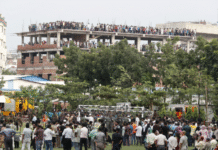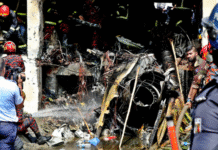
SAVAR, Bangladesh – Barely 20 miles from the national capital, this gritty suburb is now a dusty, chaotic industrial center littered with factories that produce clothes for leading Western brands. Building codes are often unenforced, regulatory oversight is flimsy and the men wielding power often travel with armed guards.
And perhaps no one wielded power more brazenly than Sohel Rana. He traveled by motorcycle, as untouchable as a mafia don, trailed by his own biker gang. Local officials and the Bangladeshi news media say he was involved in illegal drugs and guns, but he also had a building, Rana Plaza, that housed five factories.
Upstairs, workers earned as little as $40 a month making clothes for retailers like J. C. Penney. Downstairs, Mr. Rana hosted local politicians, playing pool, drinking and, the officials say, indulging in drugs.
Now Mr. Rana, 35, is under arrest, the most reviled man in Bangladesh after the horrific collapse of Rana Plaza last week left nearly 400 people dead, with many others still missing. On Tuesday, a top Bangladeshi court seized his assets, as the public bayed for his execution, especially as it appears that the tragedy could have been averted if the frantic warnings of an engineer who examined the building the day before had been heeded.
But if Mr. Rana has been vilified, he is partly a creation of the garment era in Bangladesh, during which global businesses have arrived in search of cheap labor to keep profits high and costs low. Directly or indirectly, international brands are now sometimes interlinked with men like Mr. Rana, and placed at risk by them.
Global apparel companies often depict their international supply chains as tightly scrutinized systems to ensure that clothing sold to American buyers is produced in safe, monitored factories. Yet their inspectors usually check safety factors and working conditions, but not the soundness of the buildings themselves, and the companies often have little control over the subcontractors who do much of the work.
Criminality and politics have long intersected in Bangladesh, especially at the local level. But the garment industry has introduced what had mostly been the missing element: money. Savar land values soared as new factories hurriedly opened to meet the new Western demand.
To build Rana Plaza, Mr. Rana and his father bullied adjacent landowners, the landowners themselves say, and ultimately took their property by force. His political allies gave him a construction permit, despite his dubious claims of title to the land, and a second permit later to add upper floors that may have destabilized the building.
Mr. Rana existed largely above scrutiny. Many local people say his political clout was such that not even the police dared to confront him. Television stations reported the cracks in the building the night before it collapsed, but no local authority prevented Mr. Rana from opening the building the next morning.
“Money is his power,” said Ashraf Uddin Khan, a former mayor of Savar, who accused Mr. Rana of being deeply involved in the drug trade. “Illegal money.”
Before Rana Plaza collapsed, Bangladesh was already in turmoil, as opposition political parties were staging nationwide strikes, known as hartals, that paralyzed the country and placed huge pressure on factory owners to meet deadlines. Weeks earlier, the Bangladesh Garment Manufacturers and Exporters Association warned that the hartals had cost Bangladesh as much as $500 million in business.
Hartals were part of Mr. Rana’s résumé. He held what appeared to be an innocuous position as secretary of the local student wing for the Awami League, the country’s majority political party. But that position translated into influence and helped him mobilize people. He developed a following that local people say he used as political muscle, sometimes to enforce strikes, sometimes to defy them.
“He had a criminal gang,” said Mohammed Khorshed Alam, an elected councilman in Savar and a member of the opposition Bangladesh Nationalist Party. He said Mr. Rana and his men carried weapons and were part of a network involved in the local drug trade.
Politics are rough in Savar. Mr. Alam walks through the city with an entourage of eight men, including a bodyguard with a sawed-off shotgun. Local officials say drug sales are widespread, though the city’s police chief says he has stamped out the problem. One of the busiest drug dens, he said, used to exist behind Rana Plaza.
Land helped create Mr. Rana’s power. His father had been a poor peasant who sold his plot in a village and bought a small parcel in Savar. As prices began to rise, the father sold a portion of that land and used his profits to start a small factory making mustard oil. He also became involved in politics with the Bangladesh Nationalist Party, then in power, and slowly grew richer.
By 2000, land prices were rising, and Mr. Rana was helping his father. They could see other hurriedly constructed buildings rising in Savar, and they decided to build Rana Plaza – except they did not have clear title to all the land.
Rabindranath Sarkar, who had bought land in partnership with Mr. Rana’s father, said the family sent thugs to seize part of his share of the land and then retaliated when he filed a complaint with the local police.
“Rana chased me through Savar with weapons,” he said. “The police wouldn’t even dare to protect me. The police were always scared of them.”
Another adjacent family said Mr. Rana sent representatives to try to persuade them to sell a plot, including a small pond, beside Mr. Rana’s land. By 2005, a year before construction started on Rana Plaza, the family said Mr. Rana simply falsified a land deed to take possession of the pond.
Bangladesh initially sought to attract foreign investment by creating special Export Processing Zones, which had higher quality buildings and tighter regulations. But as demand from foreign buyers rose, factories began sprouting across the country, including quickly built structures to accommodate the small operators who did subcontract work on tight margins.
By 2011, Mr. Rana had rented out the existing five floors and gotten a permit from the local mayor, a political ally, to build additional floors. Mr. Khan, the former mayor, said this practice created serious risks, since officials were handing out permits, often for bribes, without insisting on the necessary safeguards.
“For the garment industry, Savar grew quickly, and in an unplanned manner,” he said. “There are so many buildings like Rana Plaza in Savar.”
Mr. Rana found factory owners to rent his new upper floors and appeared to be gaining in influence. Then on April 23, a problem arose. Workers on the third floor were stitching clothing when they were startled by a noise that sounded like an explosion. Cracks had appeared in the building. Workers rushed outside in terror.
By late morning, Mr. Rana’s representatives had brought in Abdur Razzaque Khan, an engineer. Taken to the third floor, Mr. Khan examined three support pillars, and became horrified at the cracks he found.
“I became scared,” Mr. Khan said. “It was not safe to stay inside this building.”
He rushed downstairs and told one of Mr. Rana’s administrators that the building needed to be closed immediately. But Mr. Rana was apparently not impressed; he was holding court with about a dozen local journalists.
“This is not a crack,” he said, according to Shamim Hossain, a local newspaper reporter. “The plaster on the wall is broken, nothing more. It is not a problem.”
But it was. The next morning, Rana Plaza collapsed. Mr. Rana managed to escape from his basement office, but was eventually discovered hiding near the Indian border. He was flown by helicopter to Dhaka and thrust before the news media, looking dazed and disheveled.
Neither Mr. Rana nor a representative was available for comment. He has previously said it was the factory owners who insisted on opening for business the day of the collapse, and several of the owners have been arrested, as was Mr. Rana’s father.
Even now, many people in Savar remained unconvinced that Mr. Rana will be punished, or that his style of business will be cleaned up. “Rana is not the only one,” said Mr. Sarkar, the man whose land was taken. “Now, we have so many Ranas.”
Julfikar Ali Manik contributed reporting.
Source: NYTimes










Hang the bastards and that’s all. Will that solve the problem? Of course not. Still hang him anyway just for the sake of all those innocent lives lost. But the reality is, nothing will happen to Rana and he will go free.
Don’t be mistaken, Mr. Hossain. It’s reported that Rana withdrew 210 million taka just the day after the collapse and everyone can guess where the money has gone. It’s because of the money that the Savar police charged him on flimsy/weak bailable sections and you’ll see after he gets bail no one will dare to bear witness against him. This was evident when even in remand and police van he physically assaulted the garment owners and threatened them with dire consequences once he is out. Just think about his confidence and courage! But what’s the main stake he leans on? Obviously the administration and the high-ups in the govt. He is in fact a golden egg laying duck for the power party. So we know what’s going to happen with his case.